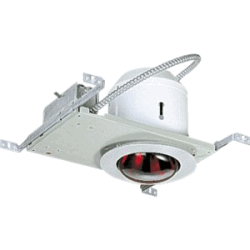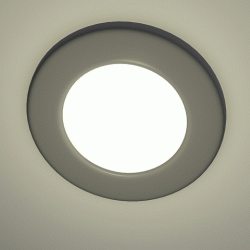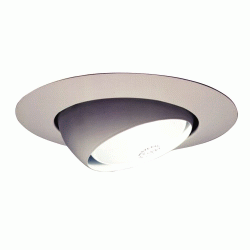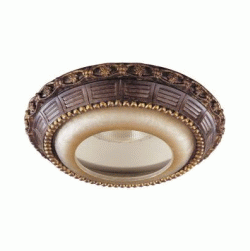Recessed Lighting Trim: Improving Appearance and Functionality
A recessed lighting trim changes the appearance of your recessed lighting and provides options for directing your light.
A recessed lighting trim can greatly change the appearance and functionality of your recessed lighting. Often, home owners reject recessed lighting on the grounds that they don’t like how it looks. However, the standard appearance of recessed lighting (glowing holes in the ceiling) isn’t the only option. A recessed lighting trim can even change the appearance of recessed lighting to the point where your visitors might not even know what it is.
Appearance
The most common type of recessed lighting trim is a flat ring that goes around the housing of each of your recessed lights. Adding this flat ring helps take away the “hole in the ceiling look” that normally comes with recessed lighting. Instead, the ring makes your recessed lighting look more like it is a lighting fixture that has somehow been pushed into your ceiling.
These rings come in a number of different styles and colors. The most basic appearance is simply a plain ring with colors that match the ceiling or highlights of your room. However, they can also have patterns on them of various kinds. For those who are looking for recessed lighting for a more classic-looking room, trims come in porcelain (or faux-porcelain) or even metals like bronze. This can offset some of the concern that recessed lighting is simply too minimalist for many rooms.

The recessed trim, like this one available at Amazon, is just the “tip of the iceberg”, so to speak.
Lighting Quality
Using recessed lighting trims can change the quality of light that comes from your recessed lighting. In general, they change lighting quality in five different ways: intensification, coloration, diffusion, direction and refraction. In this section, I will discuss each of these options and how recessed lighting trims can be used to produce that effect in your light.
Intensification
Most recessed lighting trims do not simply go on the outside of your recessed lighting canister, but actually go inside of the canister itself. For instance, a trim might include a gold-colored cylinder that goes inside of the canister and makes the inside of the canister appear gold.
This can substantially alter the quality of the light that comes from the canister. Without a reflective surface, the light that hits the side of the canister is either absorbed (if the canister is dark colored) or diffused (if the canister is light colored).
With a reflective surface, however, this light is simply reflected. This makes the light that comes out of the canister much more intense, providing deeper shadows and stronger accent lighting. Whether this is good or bad depends on what you want to do with the lighting. For faces or task lighting, shadows are generally bad, but for decorative, accent lighting, shadows are generally good.
Diffusion

Diffusers soften the light that comes from recessed lighting.
In fact, diffusers can help offset many of the worst aspects of recessed lighting. The effect of recessed lighting on faces is, well, awful. The harsh shadows produced by recessed downlights, especially in reflective canisters, accentuate wrinkles and makes people look ten year older.
Diffusers can offset (though not completely eliminate) this problem, as diffuse light produces must weaker shadows, making them look “fuzzy”. As a result, recessed lighting using a diffuser tends to provide light that is much closer to the light produced by pendant or other traditional forms of lighting.
Direction
One exciting option with recessed lighting trims is to use them to actually direct the light that comes from your recessed lighting. The most common of these trims is called an “eyeball lighting trim”. Such trims have a little “eyeball” in the middle that direct the light that comes out of the recessed light in a single direction.

Eyeball trims, like this one available at Amazon, allow flexibility in the direction of light.
A possible disadvantage of eyeball trims, however, is that they provide more intense light. In order to redirect the light in a given direction, eyeball trims use reflective surfaces, which necessarily intensify the light for the reasons mentioned before. This means that, unless you are using the lights specifically for accent lighting or wall washing, you should probably avoid eyeball trims.
Refraction
Recessed lighting trims may provide refraction of light. This refers to the breaking up of light into many different, little beams of light. In general, this is done by using crystal-shaped pieces of glass (or with crystal itself). Light that enters crystal-shaped glass exits it in a number of different directions, providing the “sparkle” that we associate with crystal and diamonds, and also providing interesting light patterns when that refractive light strikes surfaces.
Recessed lighting trims can provide refraction by either putting a crystal-shaped-glass cover directly over the housing, or by placing crystal-shaped glass around the edges of the housing, dangling like a pendant. In both of these cases, your recessed light is turned into a miniature chandelier, providing both decoration and a different light quality.
Refraction is currently uncommon in recessed lighting trims, but that may change as more people purchase homes with recessed lighting whose appearance they dislike but that they do not wish to uninstall. Refraction has many of the same advantages of diffusion mentioned above, as it breaks up the harsh shadows typically cast by recessed downlighting.
Coloration

Many recessed trims, like this one available at Amazon, don’t look like “recessed lighting” at all.
Colored reflection: Using any color other than silver (such as gold) when reflecting light will change its color.
Colored diffusers: Using a colored, translucent covering on the housing will alter the color of the light.
Colored refraction: Using colored, dangling pieces of glass will alter the color of the light that goes through those pieces.
When choosing a trim, it is important to think about how the color of the light will affect the room’s overall design. Warm colors look good on people, white light is good for tasks and cool colors look good on plants. Depending on what kind of purposes the light is serving, different colors may be appropriate.
Putting It All Together
A recessed lighting trim can provide your recessed lighting not only with a different look but with a different lighting quality:
- Recessed lighting trims can change the appearance of recessed lighting so that it doesn’t look like “holes in the ceiling”.
- Recessed lighting can change lighting quality through intensification, diffusion, direction and refraction.
If you do have recessed lighting, trims can provide a number of options that make recessed lighting, otherwise the most inflexible of all lighting, a lot more flexible.
Back from Recessed Lighting Trim to Recessed Lighting Fixtures